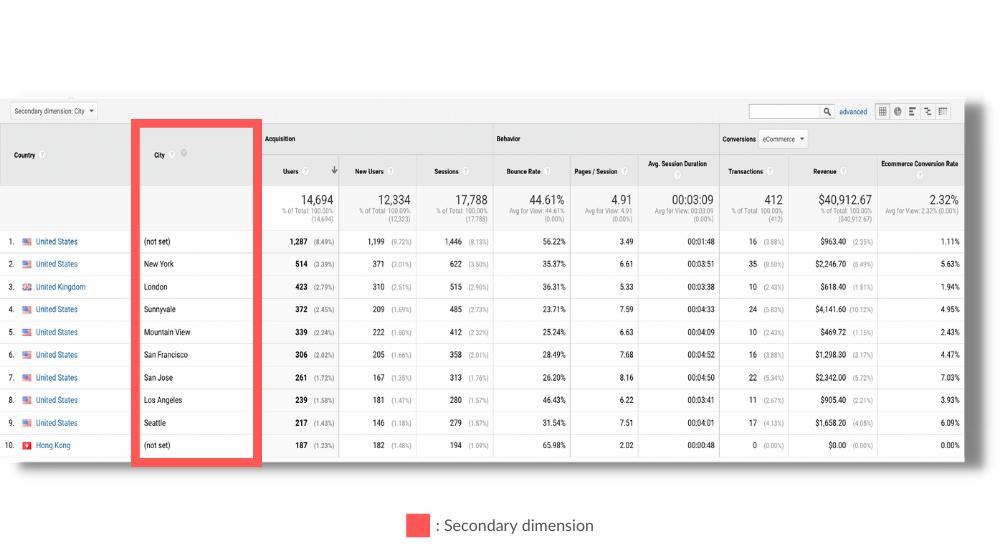Introducing the Intricacies of Secondary Dimension in Google Analytics: a Comprehensive Guide on Just How It Functions
Browsing the detailed realm of second measurements in Google Analytics is a job that calls for an eager understanding of how this attribute operates within the system. As digital landscapes progress and data ends up being significantly crucial for decision-making, grasping the subtleties of second measurements can be the secret to unlocking important understandings. From establishing up reports to delving into advanced techniques, the journey to utilizing the power of second measurements is both difficult and gratifying. Join us as we discover the ins and outs of this tool and discover how it can change your data analysis approaches.
Fundamentals of Secondary Measurement in Google Analytics
When evaluating information in Google Analytics, utilizing the secondary measurement function supplies beneficial insights into the efficiency of various metrics. The additional dimension permits users to additionally explore their data by adding an extra layer of info to their primary measurements. By doing so, experts can gain a much more thorough understanding of the factors influencing their site's performance.
In Google Analytics, the main dimensions represent the primary categories of data, such as web traffic sources or gadgets. When an additional dimension is used, it gives a much deeper level of granularity by revealing an additional element of the information within the selected main dimension. If the main measurement is 'Traffic Resource,' including an additional measurement like 'Touchdown Web page' can reveal which details pages are driving website traffic from each resource.
This function is especially valuable for determining patterns, relationships, and fads that might not be instantly noticeable when checking out the data from a single dimension. By leveraging the second dimension in Google Analytics, individuals can reveal useful insights that can educate critical decisions and optimizations to enhance internet site efficiency.
Establishing Secondary Measurement Reports
Broadening on the insights obtained via the use of secondary dimensions in Google Analytics, the procedure of setting up additional measurement records entails setting up additional layers of information to even more improve the deepness of evaluation (what is a “secondary dimension” in google analytics?). To start this arrangement, users can navigate to the reporting area in Google Analytics and choose the main record they desire to dive much deeper right into. When the main record is picked, individuals can click on the "Additional measurement" tab situated over the data visualization area. From there, a drop-down menu will certainly show up, offering a plethora of choices to select the additional measurement that finest enhances the main data set. Customers can select from a large range of second measurement metrics such as behavior, modern technology, traffic resources, and even more to get an extra detailed understanding of customer communications on their web site. By integrating primary and second dimensions, businesses can extract richer insights and make even more informed choices to maximize their online visibility successfully.
Leveraging Additional Dimensions for Insights
Using secondary measurements in Google Analytics uses a tactical strategy to drawing out nuanced insights for notified decision-making in online organization optimization. By integrating key dimensions with second measurements, companies can dig much deeper right into their information to reveal useful correlations and patterns that may not be instantly evident. As an example, by segmenting website traffic by geographical location (primary dimension) and after that including an additional dimension like gadget classification, services can recognize if certain regions like accessing the website by means of mobile or desktop computer.
In addition, leveraging additional measurements allows companies to obtain a far better understanding of user behavior and preferences. Analyzing conversion prices based on web traffic resources (main dimension) along with the secondary measurement of landing pages can disclose which details web pages are most effective in driving conversions for natural search website traffic versus social media web traffic. These insights can after that inform advertising and marketing approaches and internet site optimization initiatives to enhance general performance and make best view use of ROI.
Advanced Methods for Secondary Measurements
To better remove detailed understandings and boost data-driven decision-making within Google Analytics, carrying out sophisticated strategies for using additional measurements is essential in unlocking much deeper layers of valuable details for business optimization. One advanced method is making use of customized measurements and metrics, enabling the tracking of particular user interactions or habits that are not captured by default in Google Analytics. By applying and specifying customized dimensions, services can tailor their monitoring to line up with distinct company goals and goals.
Another advanced technique includes using filters in conjunction with second dimensions. Filters allow customers to refine the data presented in Google Analytics records, providing more targeted and relevant understandings. By using filters strategically with second dimensions, businesses can sector information better, resulting in a clearer understanding of individual actions and performance metrics.

Optimizing Information Evaluation With Secondary Measurements

Furthermore, enhancing data Continue analysis with second dimensions entails trying out with various mixes to recognize patterns and correlations that may not be instantly evident. This iterative technique allows experts to adjust their coverage and focus on the most relevant data points for their company objectives. Ultimately, by leveraging second measurements successfully, analysts can improve the accuracy and efficiency of their information analysis efforts in Google Analytics.
Final Thought
To conclude, understanding the ins why not look here and outs of additional measurements in Google Analytics is essential for acquiring deeper understandings into internet site efficiency. By establishing second measurement reports, leveraging them for insights, and using innovative strategies, analysts can enhance data analysis and make informed decisions. This thorough overview has actually offered a comprehensive introduction of exactly how additional dimensions job and their importance in boosting the logical abilities of Google Analytics users.
The secondary dimension enables individuals to additionally explore their information by including an additional layer of details to their primary measurements. When an additional dimension is used, it gives a deeper degree of granularity by showing an additional facet of the information within the selected main dimension.Increasing on the understandings gained with the utilization of additional measurements in Google Analytics, the process of establishing up second dimension reports entails setting up extra layers of information to even more enhance the depth of analysis. By integrating primary dimensions with second dimensions, organizations can delve much deeper into their information to uncover valuable relationships and patterns that might not be quickly noticeable. One method to maximize information analysis with secondary measurements is to incorporate them with key measurements to get an extra extensive view of site performance.